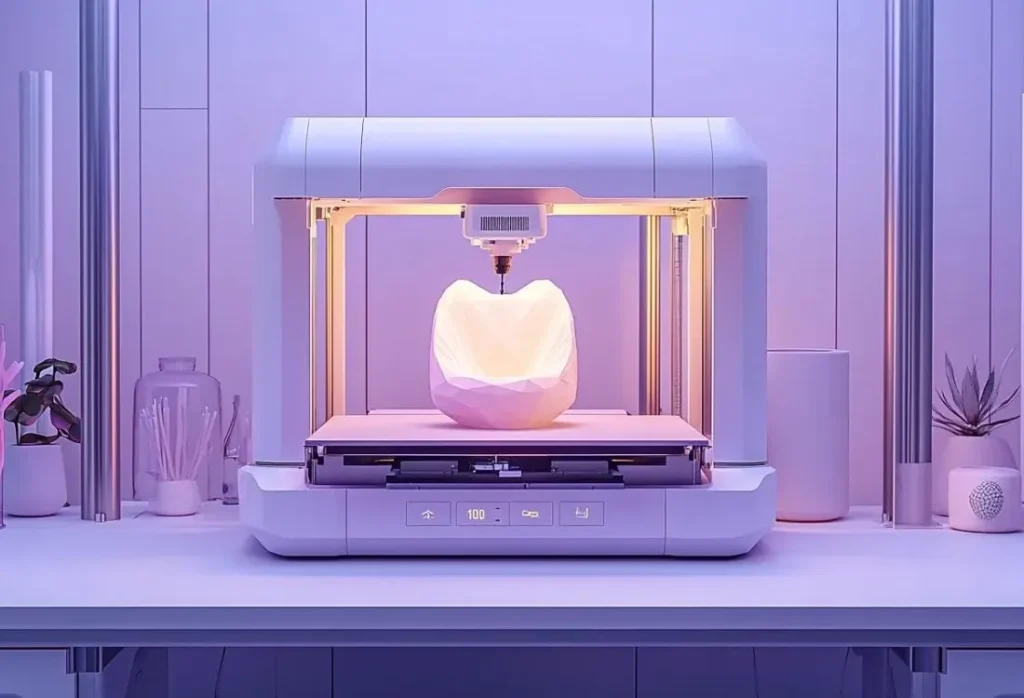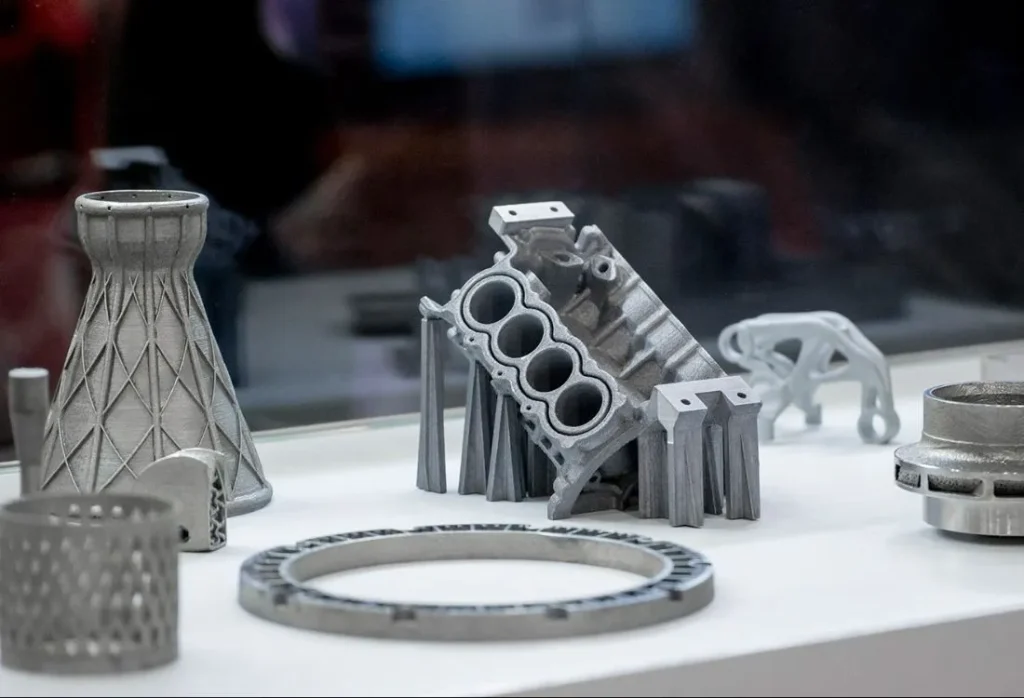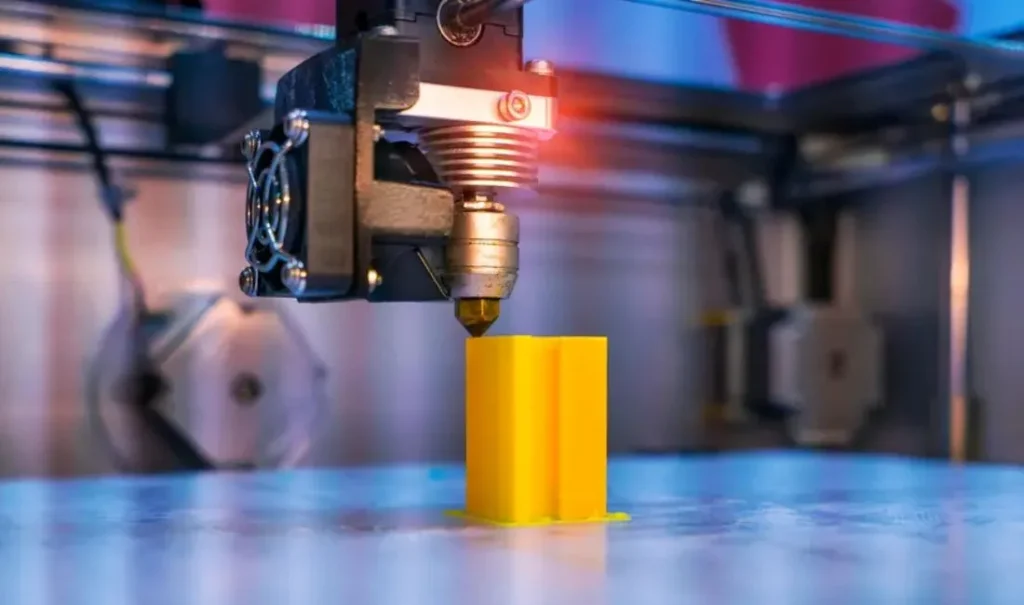Imagine turning an idea into a real object in hours, not weeks. That’s the power of 3D printing—your concept goes from digital sketch to tangible item faster than ever.
For DIY makers and small business owners in the USA, this means far more freedom. You can test ideas without huge tooling costs. You can make custom gifts, one‑off parts or niche products on demand. Reports show this tech boosts customization, slashes waste and tightens supply chains.
What is 3D Printing?
3D printing, also known as additive manufacturing, is a process that converts a digital design into a physical object.
Unlike traditional manufacturing, it builds objects layer by layer, rather than cutting material away.
You start with a digital model, then the printer lays down thin layers of material until the object is complete.
Revolutionizing Manufacturing 3D Printing is transforming how products are made. For instance, companies can create custom prototypes in just a few hours instead of weeks, reducing material waste and speeding up innovation.

Simple Explanation of the Process (Additive Manufacturing)
Here’s how 3D printing generally works:
- Design: You create or download a 3D model of the object you want.
- Slicing: Software slices the model into very thin layers. The printer uses this guide for printing.
- Printing: The printer deposits material layer by layer, gradually forming the object.
- Post-Processing: After printing, remove supports, smooth surfaces, or cure the material.
This method utilizes only the necessary materials, thereby reducing waste and enabling the creation of complex shapes that are challenging to produce with traditional methods.
Differences Between 3D Printing and Traditional Manufacturing
Here’s how 3D printing stands out:
- Material use: 3D printing adds only the material required, while traditional methods often remove material from a larger block.
- Tooling and setup: Traditional manufacturing needs molds or specialized tools, which cost time and money. 3D printing requires minimal setup.
- Customization and complexity: 3D printing can produce intricate, custom shapes without large cost increases. Traditional methods may struggle with complex designs.
- Production volume: Traditional manufacturing is better for mass production. 3D printing is ideal for prototypes, small runs, or custom items.
In short, 3D printing gives flexibility, speed, and creative freedom that older methods can’t easily match.
How 3D Printers Are Accessible for Beginners and Hobbyists in the USA
3D printing is now very accessible, even for individuals or small businesses:
- Affordable machines: Entry-level desktop 3D printers are now within reach for hobbyists and beginners.
- Easy-to-use designs: Many machines are plug-and-play with beginner-friendly software.
- Material variety: Users can experiment with plastics, resin, and other safe printing materials.
- Support and community: Online communities offer tutorials, troubleshooting help, and shared 3D models.
- Domestic availability: In the USA, printers and materials are readily available, and support is easily accessible locally.
This makes it possible to start small, explore creativity, and even create a side business from home.
How 3D Printing Transforms Ideas Into Reality
3D printing turns digital ideas into real objects quickly and affordably. What once took weeks, now happens in hours.
From Digital Sketch to Physical Form
Start with a digital design. The printer builds the object layer by layer. You can test, tweak, and print again, making creativity fast and hands-on.
Prototypes and Experimentation
Rapid prototyping lets designers and hobbyists test ideas without high costs. Early flaws are easy to fix, saving time and money.
Custom Gifts and Unique Creations
3D printing allows personalization. Create figurines, décor, or gifts with names or custom designs. One-of-a-kind objects leave lasting impressions.
Replacement Parts and Practical Fixes
Need a broken knob or missing piece? Print replacements at home. Adjust dimensions, test, and solve problems instantly.
Miniatures and Creative Expression
Print miniatures, models, and collectibles. Artists and hobbyists can bring imagination into tangible forms with detail and precision.
Why It Matters
- Speed: Ideas to objects in hours.
- Low cost: Small runs without molds.
- Flexibility: Adjust and iterate designs.
- Accessibility: Desktop printers bring production home.
- Creativity: Personalize shapes, colors, and textures.
3D printing bridges the gap between imagination and reality, allowing DIYers, makers, and small businesses to bring their ideas to life quickly and creatively.

3D Printing for DIY Enthusiasts
Benefits for Hobbyists: Personalization, Experimentation, Low-Cost Prototypes
A home 3D printer gives you the freedom to create personalized items. You can design a unique phone stand, a custom gift, or a miniature figurine. Your ideas become real objects in hours.
It’s also perfect for experimentation. You can try different shapes, materials, and designs without spending a fortune. This flexibility encourages creativity and learning.
Hobbyists can also build low-cost prototypes. Instead of paying for professional parts or molds, you can print your own. This reduces waste, saves money, and shortens the time from idea to finished object.
The joy of seeing your design come to life is unmatched. For hobbyists, 3D printing blends digital design with hands-on creation.
Choosing the Right 3D Printer for Home Projects
Selecting a 3D printer for your home depends on several factors:
- Budget and Size: Decide how much you want to spend and the maximum object size you want to print. Many beginner-friendly machines are affordable and compact.
- Ease of Use: Look for auto-bed leveling, simple controls, and clear instructions. These features reduce frustration for first-time users.
- Material Compatibility: PLA is great for simple projects. For more advanced printing, consider ABS, PETG, or specialty filaments.
- Build Volume: The printer’s bed size determines how big your objects can be. Choose one that fits your projects.
- Support and Community: A strong maker community helps with troubleshooting, tips, and upgrades.
- Safety and Location: Consider ventilation and space. Some materials emit fumes, so proper setup is important.
- Upgrade Potential: Beginners may start simple, but a printer that allows upgrades grows with your skills.
- Reliability: A sturdy printer saves time and frustration, letting you focus on creativity instead of repairs.
Popular Beginner-Friendly 3D Printers in the USA
Here are a few widely recommended printers for hobbyists:
- Creality Ender 3 V3 SE: Affordable, reliable, and widely used by beginners. Good for small to medium-sized projects.
- Prusa MK4 / Mini: Known for high-quality prints, excellent support, and strong community. Slightly higher cost but very reliable.
- Bambu Lab A1 Mini: Compact, easy to use, and comes with advanced features for beginners who want a smooth experience.
For DIY enthusiasts, 3D printing opens a world of creativity. Whether you want personalized gifts, experimental designs, or low-cost prototypes, the right printer makes the process enjoyable and accessible.
3D Printing in Business
3D printing provides small businesses in the USA with a powerful means of creating unique products. It allows owners to make custom items, produce on demand, and serve niche markets. Entrepreneurs can design and print everything from jewelry and décor to spare parts and tools with minimal investment.
This technology saves both time and money. Products can move from idea to reality in hours, rather than weeks. Since 3D printing uses only the needed material, it reduces waste and costs. Businesses can print small batches or one-off items, avoiding the expense of mass production.
Across the country, many companies are already utilizing 3D printing to expand. From local designers selling personalized products online to manufacturers producing prototypes and replacement parts, it helps them stay creative, flexible, and competitive.

Materials and Methods
Common Materials
Choosing the right material decides how your 3D print looks, feels, and performs.
- PLA (Polylactic Acid): Easy to print, affordable, and eco-friendly. Great for beginners and decorative items.
- ABS (Acrylonitrile Butadiene Styrene): Strong and heat-resistant, perfect for durable parts and functional models.
- Resin: Used in resin printers for high-detail models with smooth finishes. Best for jewelry, figures, or prototypes.
- Metal Filaments: Blend of metal and plastic for a realistic metallic look. Ideal for art, tools, or premium products.
Basic 3D Printing Methods
There are three main ways 3D printers create objects:
- FDM (Fused Deposition Modeling): Melts plastic filament and builds layer by layer. Most common and budget-friendly.
- SLA (Stereolithography): Uses UV light to cure liquid resin. Produces smooth, detailed models but costs more.
- SLS (Selective Laser Sintering): Fuses powder with a laser to make strong, complex shapes. Used mainly in industrial projects.
Choosing the Right Option
Your choice depends on purpose and budget:
- For simple, low-cost projects → use PLA with FDM.
- For fine detail or display models → choose resin with SLA.
- For strong, functional parts → go with ABS or SLS.
Always match your material to your goal—strength, look, or price.
Tips for Successful 3D Printing
Creating great 3D prints takes more than just pressing a button. Smart steps save time, reduce waste, and improve results. Whether for home or business, these tips will help you succeed.
Design Tips for Beginners
1. Start with simple shapes
Begin with easy models like cubes, brackets, or small objects. Simple designs help you learn your printer’s behavior and reduce failed prints. Complex designs with overhangs or curves often need more support.
2. Add supports where needed
Overhangs and bridges can collapse without support. Use your slicer to generate supports, or rotate your model to reduce unnecessary supports. Fewer supports mean cleaner prints and easier post-processing.
3. Always check your scale
Ensure your model’s dimensions match the real-world size. Thin walls may break, while overly thick walls waste material and time. Check both scale and wall thickness before printing.
4. Match material and printer
Different materials behave differently. PLA is beginner-friendly, while ABS or PETG need higher temperatures. Choose material suitable for your design and strength requirements. Know your printer’s limits to avoid clogs or failed prints.
5. Test and iterate
Print small prototypes before committing to large models. Testing helps you identify design flaws and adjust settings accordingly. Learning from test prints improves final results.
Maintenance Tips for 3D Printers
1. Keep it clean
Clean the nozzle and build plate regularly. Dust or old filament residue can reduce adhesion and cause print failures.
2. Calibrate regularly
Level the bed and check nozzle height. Poor calibration leads to weak first layers or shifting prints. Inspect belts and alignment for smooth printing.
3. Update software and firmware
Keep your printer and slicing software up to date. Updates enhance performance, resolve bugs, and introduce features that simplify printing.
4. Store filament properly
Filament absorbs moisture, which can cause bubbles, weak layers, or poor adhesion. Keep spools sealed in a dry, cool place.
5. Perform monthly check-ups
Inspect belts, fans, rails, and cables. Tighten loose parts and lubricate when needed. Regular upkeep prevents bigger issues later.
Avoiding Common Mistakes
1. Don’t rush setup
Many failed prints happen when users skip bed leveling or ignore the first layer. Always take time to prepare properly.
2. Design for print realities
Models that look good on a computer may fail in real life. Watch for thin walls, unsupported overhangs, or fragile sections.
3. Use correct settings and material
Speed, temperature, infill, and filament choice affect print quality. Wrong settings can cause warping, weak prints, or wasted material.
4. Inspect prints for quality
For personal or business use, always check parts for defects, fit, and finish. Consistency builds trust if selling 3D-printed items.
5. Plan post-processing
Most prints need cleanup. Remove supports, sand rough edges, and polish surfaces. Don’t expect a perfect finish straight from the printer.

The Future of 3D Printing
Innovations
3D printing is evolving fast. Bioprinting now allows printing of living tissues and organ parts. Large-scale printers build homes and infrastructure using concrete and composites. Sustainable materials like biodegradable plastics and recycled filaments reduce waste and environmental impact.
Impact on DIY and American Businesses
Affordable 3D printers let hobbyists bring creative ideas to life at home. Small businesses use 3D printing for custom products, on-demand manufacturing, and niche markets. Local production saves time, cuts costs, and encourages experimentation.
Encouragement to Explore
You don’t need to wait. Start with a simple printer or local maker-space. Experiment with one material, print, tweak, and improve. Focus on creativity, sustainability, and learning. Small efforts today can lead to big innovations tomorrow.
Wrapping Up
By embracing the journey from idea to object, you unlock the true power of 3D printing. This technology transforms digital designs into real‑world creations with speed, flexibility, and personalization. Whether you’re a DIY enthusiast printing custom models at home or a small business crafting niche products, 3D printing opens new doors. It slashes development time, cuts waste, and gives you creative control. As materials and tools become more accessible, your next big idea can go from concept to creation faster than ever. Let’s get printing.
FAQs – The Power of 3D Printing
What is 3D printing?
3D printing is a process that turns digital designs into real objects, layer by layer. It’s also called additive manufacturing.
Can beginners use 3D printers at home?
Yes! Many 3D printers are user-friendly. Beginners can start with simple designs and gradually create more complex objects.
How can 3D printing help my small business?
It allows fast prototyping, custom products, and on-demand manufacturing, saving time and money for small businesses.
What materials can I use in 3D printing?
Common materials include PLA, ABS, resin, and metal filaments. Your choice depends on your project and printer type.
Do I need design skills to start 3D printing?
Basic skills help, but beginner-friendly software makes it easy to start. Templates and ready-to-print files are widely available.
